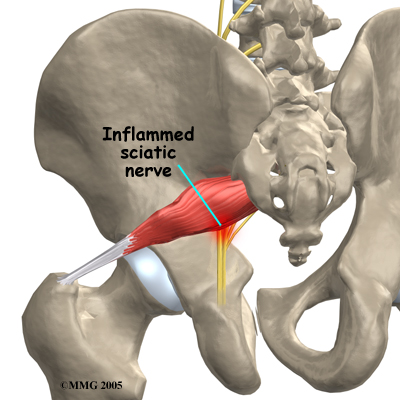Balls and Walnuts
more than you ever wanted to know
- About
- All Change
- Big pix
- Dormies
- Ear, Nose, Throat, and Soul
- Heaven on Earth
- Karen’s memoriam . . . booklet and eulogy
- Lyvvie’s email
- Magic Schoolbus does your nose and throat
- Nest: scene one
- Sex and the Single Wendigo
- Sprouts
- The Mechanic
- Two Birds, One Stone
- Excerpt: Gator and Shark Save the World
Pain in the ass

Yup, that's where it hurts.
Always cool to rediscover something that I’d learned in med school then promptly forgotten. Not so cool when I learn it the hard way. It seems I’ve developed piriformis syndrome.
Piriformis syndrome is a neuromuscular disorder that occurs when the sciatic nerve is compressed or otherwise irritated by the piriformis muscle causing pain, tingling and numbness in the buttocks and along the path of the sciatic nerve descending down the lower thigh and into the leg.
I try to exercise anywhere from three to five days a week, and generally stick to low impact aerobics such as using the elliptical trainer or fast walking on the treadmill. Last Wednesday, though, I wanted to see what it would feel like to run. So for two bloody minutes, I upped the speed to 5.2 mph. Not even six. I see people twenty years older than me running at 6 — surely I could handle 5.2 for a couple minutes? Apparently not.
What started out as a sore ass got progressively worse. For the last 24 hours I’ve been living on ibuprofen, and the pain was still enough to wake me up. Figuring I had done some major damage to my hip joint, I wormed my way into Urgent Care and begged for help. My doc, a great guy who recently received our organization’s highest clinical honor, diagnosed me in about two minutes. Got a shot of Toradol, a prescription for steroids, and some exercises on stretching, but of course I had to surf the net for more information.
From this website, for example, I learned that I may have had piriformis syndrome for a very long time. I can remember having similar pain as an undergraduate. The chief causes of piriformis syndrome: sitting on your ass all day, exercising only the muscles of forward motion (I biked a lot in college, and nowadays I do the elliptical far more often than I use the adductor/abductor machines), and having weak abdominals. Guilty on all three counts, then and now. This also explains why exercise helps my lower back pain, since when I’m doing it right, I do exercise the abdominals and stretch things out fairly well — both important for piriformis health.
And if I needed any more motivation to keep my piriformis in good shape, here’s Wiki again:
The result of the piriformis muscle spasm can be impingement of not only the sciatic nerve but also the pudendal nerve. The pudendal nerve controls the muscles of the bowels and bladder. Symptoms of pudendal nerve entrapment include tingling and numbness in the groin and saddle areas, and can lead to urinary and fecal incontinence.
I’ll close with a stretch.
D.
4 Comments
Find it
Blogroll
- Beth
- Blue Gal
- Charlene Teglia
- Chris and Dean
- Crystal
- dcr, the one, the only
- Erin O’Brien
- Fanatic Cook
- fiveandfour
- Gabriele
- If I Ran the Zoo
- Indecision 2008!
- jmc
- Kate Rothwell
- Kris Starr
- Lyvvie
- Matt’s recovery blog
- Mike Imlay
- Paperback Writer
- Pat Johanneson
- Raw Dawg Buffalo
- Science Blogs
- Shaina
- Shelbi
- Smart Bitches
- Steve Bunche
- Steven Pirie
- Tam’s blog
- The Amanda Files
Archives
Meta
Categories
Pages
- About
- All Change
- Big pix
- Dormies
- Ear, Nose, Throat, and Soul
- Excerpt: Gator and Shark Save the World
- Heaven on Earth
- Karen’s memoriam . . . booklet and eulogy
- Lyvvie’s email
- Magic Schoolbus does your nose and throat
- Nest: scene one
- Sex and the Single Wendigo
- Sprouts
- The Mechanic
- Two Birds, One Stone
Huh – there’s a yofa stretch I do that apparently gets both sides at onece. I’ve been doing it for a while, and had no idea what I was stretching. Good to know.
Too bad my problem is way too high for that stretch to do any good. It’s on top of my lower two ribs right next to the sine. 🙁
If you ever find the name for that particular yoga position, let me know — I’m sure I could find it online or in one of my books.
I do a similar stretch for my iliotibeal band. Just sitting cross-legged will stretch that (especially if you lean forward over your feet), or putting one ankle on the other knee and leaning forward. Pigeon pose is also good (i.e. exquisitely painful if your ITB is tight), as is Matsyendrasana (which also stretches the vertical muscles in your back) or Ardha Matsyendrasana.
Thanks, Chris! Ooh, and I found a link. I know this pose.